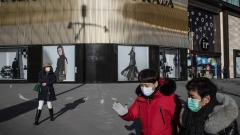Nov 4, 2019
A New Exhibition Reveals Detroit’s Hidden Art Collections
, Bloomberg News
(Bloomberg) -- Detroit’s art scene last made national headlines in 2013, when the city explored selling the contents of the Detroit Institute of Arts to pay off its crippling municipal debt. The museum’s entire collection, which includes works by Velázquez, Van Gogh, and Rembrandt, was potentially up for grabs.
Even as a backlash to the sale mounted (the city eventually dropped the plan), a small, tightknit group of collectors was working on its own to foster arts and patronage in downtown Detroit through a group called the Detroit Fine Arts Breakfast Club. What started in 2009 as an informal grouping led by the collectors Harold Braggs and Henry Harper became, over time, a place where hundreds of people would meet local artists, view their art, and sometimes buy it.
“I just bought two artworks last week from someone in the Breakfast Club,” says Deborah Ford, a judge on Michigan’s 36th District Court and a collector of African American art. “I think they’re fabulous.”
That grouping has become the impetus for a forthcoming show at the Detroit Institute of Arts called Detroit Collects: Selections of African American Art from Private Collections (Nov. 12-March 1). There are 60 objects in total, drawn from 19 private collections.
The show includes one of the contemporary artist Nick Cave’s famous Soundsuits, an ebullient, full-body costume; an oil painting by Beauford Delaney, one of the midcentury pioneers of the Harlem Renaissance; and an image by the contemporary photographer Carrie Mae Weems, a MacArthur “genius” grant winner who had a retrospective at the Guggenheim Museum in 2014.
“The reality is that Detroit is one of the cities that’s supported African American art the most,” says Salvador Salort-Pons, the DIA’s director. As the museum assembled the exhibition, “there were some people we didn’t know who are big collectors, and then there are people who are already engaged with the museum.”
Not coincidentally, the exhibition comes at a time when both the city of Detroit and the market for African American art are on a major upswing. Real estate in the city has skyrocketed—as of last year, the right purchase in Detroit would have yielded a return of more than 190 percent—restaurants continue to open, and the artworks championed by the city’s patrons have become increasingly sought-after. There’s a work by the artist Kerry James Marshall in the forthcoming DIA show, for instance. Last year, one of his paintings sold for a record-setting $21 million at auction.
As a result, Detroit Collects is notable not simply for the works on view, but as a confident statement of the city’s place in the firmament of global contemporary art. “I think the whole image of Detroit in regards to art is going to undergo some serious changes,” says Ford’s husband, the attorney Jerome Watson. “We have this image of the DIA selling off its great works because it’s nearly bankrupt. But there’s been an art renaissance in Detroit, there are all kinds of gallery openings and previews and shows every day of the week.”
A Core Group
Like most museums, the DIA has always relied on a core group of dedicated patrons. “I would say there were five or 10 families,” says Michael Kan, who retired as curator of the DIA’s African Art department in 2002. “That was standard, going back to the founding of the museum.”
Led for decades by various descendants of Henry Ford’s family, that core group of donors championed large-scale projects, and made large-scale donations, that were an attempt to cement the museum’s place in the larger cultural conversation.
“That idea that Detroit deserves a type of attention that it might not be getting goes way back,” Kan says. “The people whose collections are on the walls of the DIA are civic-minded—they wanted to contribute to something that the people who worked in their factories would have been able to enjoy and look on with their own civic pride.”
Kan organized a Detroit Collects show in 1977—Detroit Collects African Art—as part of an effort to be “tremendously engaged with the public,” says Robert Jacobs, whose family founded the chain Buddy’s Pizza and who’s been a collector in the Detroit area since the 1970s. “He’d also work with collectors to get them interested and involved in the museum.”
A Change in Focus
In that respect, the forthcoming Detroit Collects show is a continuation of the museum’s century-long engagement with the city and its public. What’s changed, participants say, is the diversity of its collectors and the focus of the art itself.
There are donors to the show whose positions are direct continuations of the DIA’s industrialist-turned-philanthropist base—the collector Richard Manoogian, for instance, is chairman emeritus of the building-products conglomerate Masco Corp., and Roy Roberts is a former General Motors Co. executive who made a seven-figure gift to the DIA with his wife, Maureen.
But the donor list also includes Cledie Collins Taylor, a retired educator and the director of Detroit’s Arts Extended Gallery, and Shirley Woodson, an artist who serves as the president of the National Conference of Artists Michigan.
“Quite frankly, the exhibition shows Detroit’s commitment to the African American community and African American art,” Jacobs says. “This museum has gone out of its way to be inclusive.”
The Art
Jacobs and his wife, Katherine, a clinical psychologist, have lent one work to the show—a 1964 painting by Bob Thompson, a figurative artist who drew from expressionist forms and styles. Ford and Watson, whose collection includes work by Romare Bearden, Jacob Lawrence, and Sam Gilliam, have lent multiple works, including a sculpture by Gilliam and a painting by the surrealist artist Hughie Lee-Smith.
Gilliam, who’s co-represented by the mega gallery Pace and David Kordansky, is a verifiable art market star, and Bearden’s collages now regularly sell for more than $300,000 at auction. (A work by Bearden, lent by the retired surgeon Walter Evans and his wife, Linda, will also be in the show.)
As the market for African American art surged and Ford and Watson continued to collect, they began to realize that they were beginning to participate in, and compete against, the zeitgeist. “It’s not that we ran out of money,” Ford says. “It’s that it became cost-prohibitive. It’s harder to find holes in the auctions where things are undervalued.”
The couple used to go to estate sales where “things would slip through the cracks,” she says. Even work at the Breakfast Club (which is now, due to demand and logistics, mostly held at night) like paintings by the Detroit artist Sheefy McFly, who makes colorful large-scale works, “used to be $100, then $150, then $300, then $600, and now it’s over $1,000,” Ford adds. “It’s jumping.”
“It means that we collect different stuff,” Watson says. “But we keep collecting.”
To contact the author of this story: James Tarmy in New York at jtarmy@bloomberg.net
To contact the editor responsible for this story: James Gaddy at jgaddy@bloomberg.net
©2019 Bloomberg L.P.


